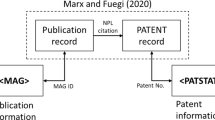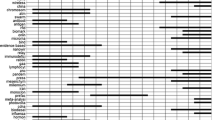Abstract
The relationship between science and technology is an important issue, as science-based technologies play a key role in modern economies. The exploration of the science-technology interface can be effectively supported by quantitative indicators, in particular patents of scientific institutions, publications of industrial enterprises, and scientific references in patent search reports. The most promising approach is the parallel observation of patents and publications in order to analyse the dynamics of the interaction of science and technology and the professional move of academic and industrial researchers between institutions.
Similar content being viewed by others
References
G. Becher, T. Gering, O. Lang, U. Schmoch, Patentwesen an Hochschulen, BMBF (Ed.), Bonn, 1997.
R. Bierhals, U. Schmoch, D. Nick, L. Pilorget, G. Walter, Industrielles Nachfragepotential für die BESSY-Synchrotronstrahlung—Ansatz zur Vernetzung von Grundlagenforschung und Industrie, report to the German Ministry for Research and Technology, Karlsruhe, 1994.
BMFT (Ed.),Deutscher Delphi-Bericht zur Entwicklung von Wissenschaft und Technik, Bonn. 1993.
W. Brunner, K. Junge,Lasertechnik, Dr. Alfred Hüthig Verlag, Heidelberg, 1984.
M. P. Carpenter, F. Narin, Validation study: Patent citations as indicators of science and foreign dependence,World Patent Information, 5 (1983) 180–185.
C. Freeman,The Economics of Industrial Innovation, 2nd edition, Frances Pinter, London, 1982.
M. Gibbsons et al.,The New Production of Knowledge. The Dynamics of Science and Research in Contemporary Societies, SAGE Publications, London/Thousand Oaks/New Delhi, 1994.
B. Gehrke, H. Grupp,Innovationspotential und Hochtechnologie, 2nd edition, Physica, Heidelberg, 1994.
H. Grupp (Ed.),Technologie am Beginn des 21. Jahrhunderts, Physical, Heidelberg, 1993; English shortened version:H. Grupp, Technology at the Beginning of the 21st Century,Technology Analysis & Strategic Management, 6 (1994) No. 4, 379–409.
H. Grupp, The dyamics of science-based innovation reconsidered: cognitive models and statistical findings, in:O. Granstad (Ed.),Economics of Technology, Elsevier, Amsterdam, 1994, 223–251.
H. Grupp, T. Schnöring (Eds),Forschung und Entwicklung für die Telekommunikation— Internationaler Vergleich mit zehn Ländern, Springer-Verlag, Berlin/Heidelberg/New York, 1990.
H. Grupp, U. Schmoch, Technologieindikatoren: Aussagekraft, Verwendungsmöglichkeiten, Erhebungsverfahren, in:H.-J. Bullinger (Ed.),Handbuch des Informationsmanagments im Unternehmen, Band II, Verlag C. H. Beck, München, 1991, 1571–1615.
H. Grupp, U. Schmoch, Perception of scientification as measured by referencing between patents and papers, in:H. Grupp (Ed.),Dynamics of Science-Based Innovation, Springer-Verlag, Berlin/Heidelberg/New York, 1992, 73–128.
H. Grupp, G. Münt, U. Schmoch, Wissensintensive Wirtschaft und ressourcen-schonende Technik. Teil E: Potentialanalyse, report to the German Ministry of Education and Research, Karlsruhe, 1995.
H. Grupp, G. Münt, U. Schmoch, Assessing different types of patent data for describing high-technology performance, in: OECD (Ed.),Innovation, Patents and Technological Strategies, Paris, 1996, 271–287.
R. Henderson, A. B. Jaffe, M. Traitjenberg, Numbers up. Quality down? Trends in university patenting 1965–1992. Contribution to CEPR/AAS Conference “University Goals, Institutional Mechanisms, and Industrial Transferability of Research” at the Stanford University, March 1994.
D. Hicks, Published papers, tacit competencies and corporate management of the public/private character of knowleged,Industrial and Corporate Change (ICC). 4 (1995) No. 2, 401–447.
S. Hinze, U. Schmoch, G. Münt, Nutzung von Online-Datenbanken zur Unterstützung von Feldforschungsprojekten am Beispiel der Neuronalen Netze, in: DGD (Ed.),Deutscher Dokumentartag 1994, Proceedings, Frankfurt/M., 1994, 121–136.
C. Knorr, U. Schmoch, P. Keen, D. Agrafiotis, Legal and institutional constraint and opportunities for the dissemination and exploitation of R&D activities. Scientific institutions in plant biotechnology. Report to the European Commission, Karlsruhe, 1996.
L. Leydesdorff, S. E. Cozzens, The delineation of specialties in terms of journals using the dynamics journal set of the SCI,Scientometrics, 26 (1993) 135–156.
E. Mansfield, Academic research and industrial innovation,Research Policy, 20 (1990) 1–12.
F. Narin, D. Olivastro, Status report: linkage between technology and science,Research Policy, 21 (1992) 237–249.
E. C. M. Noyons, A. F. J. Van Raan, H. Grupp, U. Schmoch, Exploring the science and technology interface: inventor-author relations in laser medicine research.Research Policy, 23 (1994) 443–457.
V. Rabeharisoa, A special mediation between science and technology. When inventors publish scientific articles in fuel cell research, in:H. Grupp (Ed.),Dynamics of Science-Based Innovation, Springer-Verlag, Berlin/Heidelberg/New York, 1992, 45–72.
M. A. Rappa, K. Debackere, Technological communities and the diffusion of knowledge,R&D Management, 22 (1992) 209–220.
U. Schmoch, Tracing the knowledge transfer from science to technology as reflected in patent indicators,Scientometrics, 26 (1993) 193–211.
U. Schmoch, Patentindikatoren und Trends in der Biotechnologie—Arbeitsteilung zwischen Forschung und Industrie. Contribution to the BMBF conference “Patentaktivitäten von Hochschulen am Beispiel der Biotechnologie”, Köln, September 21–22, 1995.
U. Schmoch, E. Strauss, H. Grupp, T. Reiss, Indicators of the scientific base of European patents, edited by the Commission of the European Communities, EUR 15330 EN, Brussels/Luxembourg, 1993.
U. Schmoch, S. Breiner, S. Hinze, K. Cuhls, The organisation of interdisciplinarity— research structures in the area of medical lasers and neural networks, in:G. Reger, U. Schmoch (Eds),Organisation of Science and Technology at the Watershed. The Academic and Industrial Perspective, Physica, Heidelberg, 1993, 267–398.
U. Schmoch, K. Koschatzky, T. Laube, M. Kulicke, D. von Wichert-Nick,Freie Erfindungen erfolgreich verwerten, Verlag TÜV Rheinland, Köln, 1996.
U. Schmoch, S. Hinze, G. Jäckel, N. Kirsch, F. Meyer-Krahmer, G. Münt, The role of the scientific community in the generation of technology, in:G. Reger, U. Schmoch (Eds),Organisation of Science and Technology at the Watershed. The Academic and Industrial Perspective, Physica, Heidelberg, 1996, 1–138.
H. Weber, G. Herziger,Laser—Grundlagen und Anwendungen, Physic Verlag, Weinheim, 1972.
Wissenschaftsrat (Ed.),Personalstellen der Hochschulen 1989. Bestand 1980 bis 1989, Soll 1990, Köln, 1990.
Author information
Authors and Affiliations
Rights and permissions
About this article
Cite this article
Schmoch, U. Indicators and the relations between science and technology. Scientometrics 38, 103–116 (1997). https://doi.org/10.1007/BF02461126
Received:
Issue Date:
DOI: https://doi.org/10.1007/BF02461126




